Molecular Insights into the Kinetic Aging Mechanisms of SBS-Modified Asphalt
Abstract
1. Introduction
2. Research Plan
2.1. Materials
2.2. Experiments and Analysis
2.2.1. Aging Tests
2.2.2. Four-Component Separation Testing and Analysis
2.2.3. FTIR Testing and Analysis
3. Molecular Models Establishment
3.1. Molecular Structure of SBSMA During the Kinetic Aging Process
3.1.1. Asphalt-Matrix Modeling
3.1.2. SBS-Polymer Modeling
3.2. Molecular Number of SBSMA During the Kinetic Aging Process
3.3. Molecular Dynamics Simulation Protocol
- (1)
- Model Construction and Energy Minimization: Molecular structures of individual components (asphalt molecules and SBS fragments) were first built and geometrically optimized using the Forcite module. This initial energy minimization, employing the Smart Minimizer algorithm with a convergence tolerance of 10−4 kcal/mol, ensured each molecule started from a stable local energy minimum.
- (2)
- Amorphous Cell Assembly: The initial three-dimensional periodic simulation cells for each SBSMA system were constructed using the Amorphous Cell module. The models were built based on the specified number of molecules from Table 3, targeting an initial low density of 0.5 g/cm3 to avoid atomic overlaps. The COMPASS II force field was selected for all simulations [31]. This force field is a high-quality, Ab Initio-based parameter set specifically validated for condensed matter systems including polymers, organic molecules, and their composites, making it highly suitable for simulating SBSMA. The atom-based summation method with a cut-off distance of 15.5 Å was applied for van der Waals interactions, while the Ewald summation method was used for electrostatic interactions [31,43].
- (3)
- Equilibrium Procedure (Annealing and NPT Ensemble): To obtain thermodynamically stable and representative models, a rigorous equilibration procedure was implemented.
3.4. The Density SBSMA Molecular Models During the Kinetic Aging Process
4. Simulation Results and Analysis
4.1. Cohesive Energy Density and Solubility Parameters During Aging
4.2. Surface Free Energy
4.3. Free Volume
4.4. Binding Energy Between SBS and Asphalt-Matrix Molecules
4.5. Radial Distribution Function
4.6. Relative Concentration
4.7. Diffusion Coefficient
5. Conclusions
- (1)
- The aging process exhibits distinct two-stage kinetics. SI and CI demonstrate rapid increases during the initial 0–5 day period, followed by stabilization of SI and gradual CI growth from 5 to 30 days, indicating faster oxidation rates in the first aging stage. Similarly, the significant initial decrease in IS and IB within 0–5 days, followed by slower changes, confirms that SBS-molecular-chain scission predominantly occurs during the first aging phase.
- (2)
- CED and δ analysis show that van der Waals interactions dominate the aging process. The faster CED increase during the first 0–5 days correlates with the formation of highly polar sulfoxide groups, compared to the less-polar ketones generated later. This initial period also features rapid SBS-chain scission, producing reactive hydroxyl and carboxyl groups that significantly enhance intermolecular interactions. Parallel trends in δ evolution and reductions in surface free energy, fractional free volume (FFV), and binding energies further confirm the first stage as the primary period of molecular reorganization.
- (3)
- Radial distribution function analysis reveals important structural changes: asphaltene–asphaltene distances decrease more rapidly in the first aging stage due to stronger sulfoxide-induced aggregation. Conversely, increasing asphaltene–resin and asphaltene–SBS distances reflect declining compatibility from asphaltene self-aggregation and SBS-chain scission, ultimately destabilizing the colloidal structure.
- (4)
- Component distribution analysis shows an evolution from initially dispersed SARA components and aggregated SBS to increasingly competitive adsorption behavior. The first aging stage establishes significant asphaltene–SBS competition, while the second stage demonstrates clear asphaltene dominance in component adsorption.
- (5)
- Diffusion coefficient measurements reveal opposing mobility trends: asphaltene and SBS show accelerated mobility during rapid first-stage aging (0–5 days), while resin, aromatic, and saturate components exhibit decreased diffusivity. These trends moderate during the second stage (5–30 days).
Author Contributions
Funding
Data Availability Statement
Conflicts of Interest
References
- Cortizo, M.S.; Larsen, D.O.; Bianchetto, H.; Alessandrini, J.L. Effect of the thermal degradation of SBS copolymers during the ageing of modified asphalts. Polym. Degrad. Stab. 2004, 86, 275–282. [Google Scholar] [CrossRef]
- Tauste, R.; Moreno-Navarro, F.; Sol-Sánchez, M.; Rubio-Gámez, M.C. Understanding the bitumen ageing phenomenon: A review. Constr. Build. Mater. 2018, 192, 593–609. [Google Scholar] [CrossRef]
- Zhong, K.; Sun, M. The rapid determination method of performance parameters and PG grade for SBS modified asphalt. IOP Conf. Ser. Earth Environ. Sci. 2019, 237, 032103. [Google Scholar] [CrossRef]
- Ma, F.; Zhu, C.; Fu, Z.; Li, C.; Hou, Y.; Jiang, X.; Wu, M. Analysis of rheological behavior and anti-aging properties of SBS modified asphalt incorporating UV absorbent and naphthenic oil (NPO). Constr. Build. Mater. 2023, 377, 130958. [Google Scholar] [CrossRef]
- Liu, F.; Li, Z.; Liu, P.; Zhang, X.; Zhou, Z. Evaluation of the rheological properties of rejuvenated SBS modified asphalt during the re-aging evolution process. Constr. Build. Mater. 2025, 482, 141705. [Google Scholar] [CrossRef]
- Zhang, D.; Zheng, Y.; Yuan, G.; Guo, H.; Zhou, Q.; Qian, G.; Liang, B. Comparative analysis of rheological and microscopic performance of SBS modified asphalt based on field aging and laboratory aging. Fuel 2023, 352, 128933. [Google Scholar] [CrossRef]
- Bai, Y.; Liu, F.; Huang, J.; Yang, Z.; Zhang, X.; Zhou, Z. Synergistic rejuvenation of Aged SBS modified asphalt via HDI/EPR composite system: Property balancing and self-healing potential. Polym. Degrad. Stab. 2025, 241, 111553. [Google Scholar] [CrossRef]
- Yu, C.; Hu, K.; Yang, Q.; Chen, Y. Multi-scale observation of oxidative aging on the enhancement of high-temperature property of SBS-modified asphalt. Constr. Build. Mater. 2021, 313, 125478. [Google Scholar] [CrossRef]
- Gidon, D.; Aydin, D.; Kizilel, S. Photo crosslinking of styrene-butadiene-styrene (SBS) networks formed by thiol-ene reactions and their influence on cell survival. Biomed. Mater. 2015, 10, 065005. [Google Scholar] [CrossRef]
- Wang, Y.; Sun, L.; Qin, Y. Aging mechanism of SBS modified asphalt based on chemical reaction kinetics. Constr. Build. Mater. 2015, 91, 47–56. [Google Scholar] [CrossRef]
- Hao, G.; Huang, W.; Yuan, J.; Tang, N.; Xiao, F. Effect of aging on chemical and rheological properties of SBS modified asphalt with different compositions. Constr. Build. Mater. 2017, 156, 902–910. [Google Scholar] [CrossRef]
- Zhang, N.; Fan, G.; Lv, S.; He, F.; Fan, X.; Peng, X.; Liu, J.; Liu, H. The influence of sbs modification on the rheological property of asphalt before and after regeneration. Constr. Build. Mater. 2021, 310, 131060. [Google Scholar] [CrossRef]
- Dong, F.; Wang, J.; Yu, X.; Jiang, M.; Guo, Y.; Wang, S.; Zu, Y.; Ren, S. Regeneration mechanisms of aged SBS modified asphalt from rap materials: Molecule structure, morphology, phase transition, and interface adhesion characteristics. Constr. Build. Mater. 2023, 388, 131689. [Google Scholar] [CrossRef]
- Zhang, X.; Tang, B.; Cao, X.; Li, J.; Zhu, H. Study on the release characteristics of volatile organic compounds from different aged asphalt. J. Clean. Prod. 2023, 423, 138774. [Google Scholar] [CrossRef]
- Tang, N.; Dong, R. Anti-aging potential of sulphur in terminal blend rubberized asphalt binder. Constr. Build. Mater. 2020, 250, 118858. [Google Scholar] [CrossRef]
- Xu, J.; Sun, L.; Pei, J.; Xue, B.; Liu, T.; Li, R. Microstructural, chemical and rheological evaluation on oxidative aging effect of SBS polymer modified asphalt. Constr. Build. Mater. 2021, 267, 121028. [Google Scholar] [CrossRef]
- Tarefder, R.A.; Arisa, I. Molecular dynamic simulations for determining change in thermodynamic properties of asphaltene and resin because of aging. Energy Fuels 2011, 25, 2211–2222. [Google Scholar] [CrossRef]
- Ding, Y.; Huang, B.; Shu, X.; Zhang, Y.; Woods, M.E. Use of molecular dynamics to investigate diffusion between virgin and aged asphalt binders. Fuel 2016, 174, 267–273. [Google Scholar] [CrossRef]
- Sirirak, K.; Vao-Soongnern, V. Molecular simulation for the effect of chain stiffness on polymer crystallization from the melts. J. Mol. Liq. 2023, 387, 122650. [Google Scholar] [CrossRef]
- Li, C.; Fan, S.; Xu, T. Method for evaluating compatibility between SBS modifier and asphalt matrix using molecular dynamics models. J. Mater. Civ. Eng. 2021, 33, 04021207. [Google Scholar] [CrossRef]
- Su, M.; Zhou, J.; Lu, J.; Chen, W.; Zhang, H. Using molecular dynamics and experiments to investigate the morphology and micro-structure of SBS modified asphalt binder. Mater. Today Commun. 2022, 30, 103082. [Google Scholar] [CrossRef]
- Tang, J.; Wang, H.; Liang, M. Molecular simulation and experimental analysis of interaction and compatibility between asphalt binder and styrene-butadiene-styrene. Constr. Build. Mater. 2022, 342, 128028. [Google Scholar] [CrossRef]
- Yao, X.; Li, C.; Xu, T. Multi-scale studies on interfacial system compatibility between asphalt and SBS modifier using molecular dynamics simulations and experimental methods. Constr. Build. Mater. 2022, 346, 128502. [Google Scholar] [CrossRef]
- Yu, H.; Ge, J.; Qian, G.; Zhang, C.; Dai, W.; Li, P. Evaluation on the rejuvenation and diffusion characteristics of waste cooking oil on aged SBS asphalt based on molecular dynamics method. J. Clean. Prod. 2023, 406, 136998. [Google Scholar] [CrossRef]
- Yu, H.; Ge, J.; Qian, G.; Shi, C.; Zhang, C.; Dai, W.; Xie, T.; Nian, T. Evaluation of the interface adhesion mechanism between SBS asphalt and aggregates under UV aging through molecular dynamics. Constr. Build. Mater. 2023, 409, 133995. [Google Scholar] [CrossRef]
- Xu, G.; Yao, Y.; Wu, M.; Zhao, Y. Molecular simulation and experimental analysis on co-aging behaviors of SBS modifier and asphalt in SBS-modified asphalt. Mol. Simul. 2023, 49, 629–642. [Google Scholar] [CrossRef]
- Hu, D.; Gu, X.; Cui, B. Effect of styrene-butadiene-styrene copolymer on the aging resistance of asphalt: An atomistic understanding from reactive molecular dynamics simulations. Front. Struct. Civ. Eng. 2021, 15, 1261–1276. [Google Scholar] [CrossRef]
- Yan, C.; Huang, W.; Lin, P.; Zhang, Y.; Lv, Q. Chemical and rheological evaluation of aging properties of high content SBS polymer modified asphalt. Fuel 2019, 252, 417–426. [Google Scholar] [CrossRef]
- Zhao, W.; Geng, J.; Chen, M.; Li, X.; Niu, Y. Analysis of SBS content quantitative determination and rheological properties of aged modified asphalt binder. Constr. Build. Mater. 2023, 403, 133024. [Google Scholar] [CrossRef]
- Tan, Y.; Zhang, J.; Zou, G.; Qin, H. Aging characterization of rheology and morphology evolution of SBS-modified asphalt. Constr. Build. Mater. 2022, 342, 128027. [Google Scholar] [CrossRef]
- Liu, F.; Wang, Q.; Zhang, X.; Zhou, Z.; Wang, X. Investigation of asphalt oxidation kinetics aging mechanism using molecular dynamic simulation. Constr. Build. Mater. 2023, 377, 131159. [Google Scholar] [CrossRef]
- Liu, F.; Bai, Y.; Liu, P.P.; Pan, X.T.; Zhang, X.; Zhou, Z.D.; Wang, J.W.; Guo, S.Y. Effect and mechanism of aging evolution on the rheological and fatigue properties of SBS-modified asphalt. Int. J. Pavement Eng. 2024, 25, 2425797. [Google Scholar] [CrossRef]
- Liu, F.; Wen, H. Prediction of rheological and damage properties of asphalt binders that result from oxidative aging. Transp. Res. Rec. 2015, 2505, 92–98. [Google Scholar] [CrossRef]
- Liu, F.; Zhou, Z.; Wang, Y. Predict the rheological properties of aged asphalt binders using a universal kinetic model. Constr. Build. Mater. 2019, 195, 283–291. [Google Scholar] [CrossRef]
- Li, D.D.; Greenfield, M.L. Chemical compositions of improved model asphalt systems for molecular simulations. Fuel 2014, 115, 347–356. [Google Scholar] [CrossRef]
- Xu, G.; Wang, H. Molecular dynamics study of oxidative aging effect on asphalt binder properties. Fuel 2017, 188, 1–10. [Google Scholar] [CrossRef]
- Qu, X.; Liu, Q.; Guo, M.; Wang, D.; Oeser, M. Study on the effect of aging on physical properties of asphalt binder from a microscale perspective. Constr. Build. Mater. 2018, 187, 718–729. [Google Scholar] [CrossRef]
- Ding, H.; Wang, H.; Qu, X.; Varveri, A.; Gao, J.; You, Z. Towards an understanding of diffusion mechanism of bio-rejuvenators in aged asphalt binder through molecular dynamics simulation. J. Clean. Prod. 2021, 299, 126927. [Google Scholar] [CrossRef]
- Liu, F.; Zhao, R.; Wang, X.; Ren, H.; Zhou, Z. Synergistic diffusion mechanisms of rejuvenator-antioxidant systems in aged asphalt: From penetration to molecular interactions. Fuel 2024, 404, 136295. [Google Scholar] [CrossRef]
- Shi, K.; Ma, F.; Liu, J.; Fu, Z.; Song, R.; Yuan, D.; Li, C. Rejuvenation effect of aged SBS-modified asphalt utilizing molecule analysis. J. Clean. Prod. 2023, 405, 136964. [Google Scholar] [CrossRef]
- Bilema, M.; Aman, M.Y.; Abdul Hassan, N.; Al-Saffar, Z.H.; Mashaan, N.S.; Memon, Z.A.; Milad, A.; Md Yusoff, N.I. Effects of waste frying oil and crumb rubber on the characteristics of a reclaimed asphalt pavement binder. Materials 2021, 14, 3482. [Google Scholar] [CrossRef]
- Ren, S.; Liu, X.; Lin, P.; Erkens, S.; Xiao, Y. Chemo-physical characterization and molecular dynamics simulation of long-term aging behaviors of bitumen. Constr. Build. Mater. 2021, 302, 124437. [Google Scholar] [CrossRef]
- Liu, F.; Wang, Q.; Zhang, X.; Guo, C. Effect of oxidation kinetic aging on the adhesion behavior of asphalt-aggregate interfaces from molecular view. Int. J. Pavement Eng. 2024, 25, 2313499. [Google Scholar] [CrossRef]
- Shao, H.; Tang, J.; He, W.; Huang, S.; Yu, T. Study on aging mechanism of SBS/SBR compound-modified asphalt based on molecular dynamics. Rev. Adv. Mater. Sci. 2023, 62, 20230106. [Google Scholar] [CrossRef]
- Li, C.; Ma, F.; Fu, Z.; Dai, J.; Wen, Y.; Shi, K. Investigation of the solution effects on asphalt binder and mastic through molecular dynamics simulations. Constr. Build. Mater. 2022, 345, 128314. [Google Scholar] [CrossRef]
- Wang, Q.; Yu, R.; Cai, L.; Chen, X.; Zhu, X.; Xiao, Y.; Zhang, X.; Zhou, X.; Fang, C. Aging resistance of polyurethane/graphene oxide composite modified asphalt: Performance evaluation and molecular dynamics simulation. Mol. Simul. 2023, 49, 298–313. [Google Scholar] [CrossRef]
- Xu, G.; Wang, H. Study of cohesion and adhesion properties of asphalt concrete with molecular dynamics simulation. Comput. Mater. Sci. 2016, 112, 161–169. [Google Scholar] [CrossRef]
- Wu, S.; Liu, Q.; Yang, J.; Yang, R.; Zhu, J. Study of adhesion between crack sealant and pavement combining surface free energy measurement with molecular dynamics simulation. Constr. Build. Mater. 2020, 240, 117900. [Google Scholar] [CrossRef]
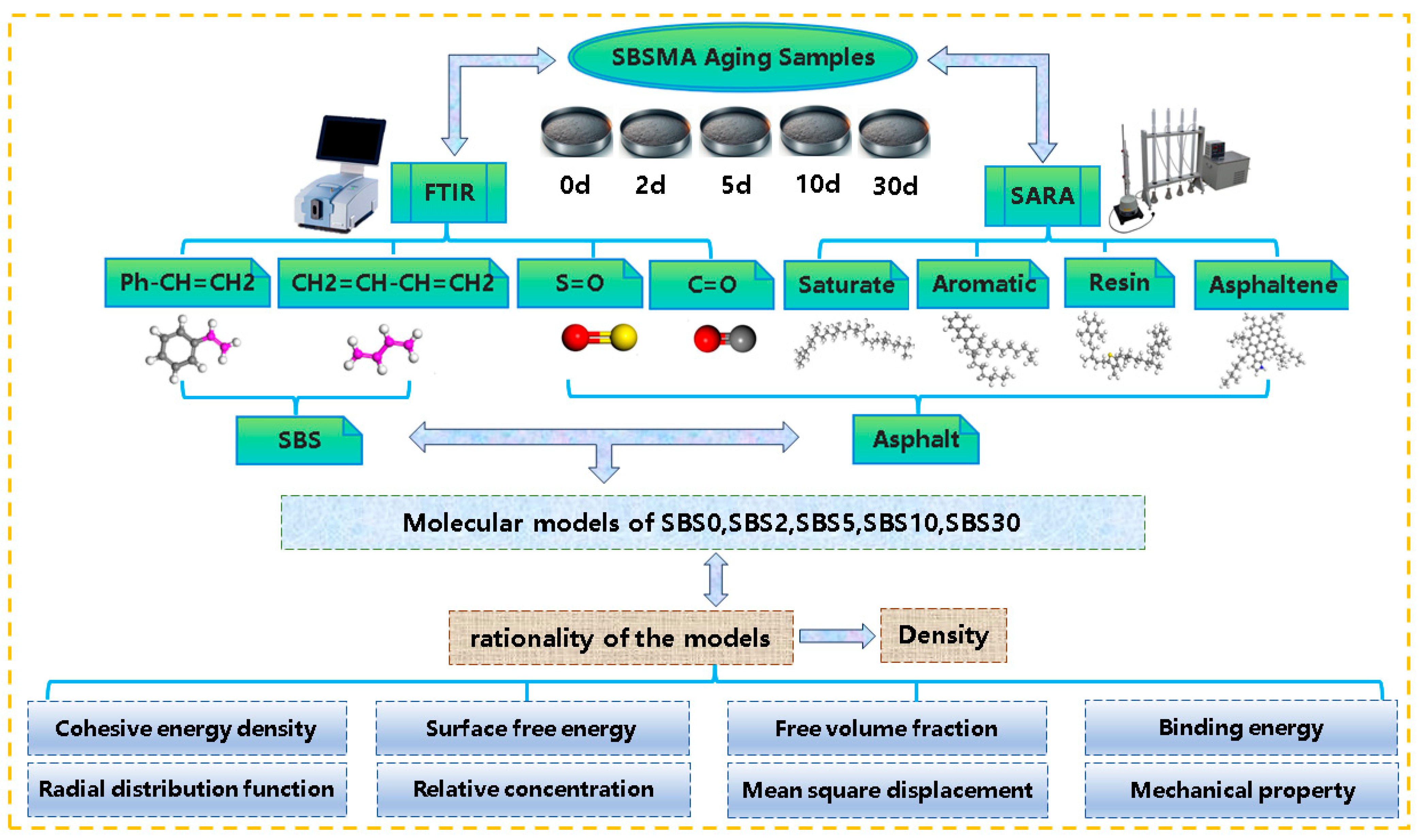
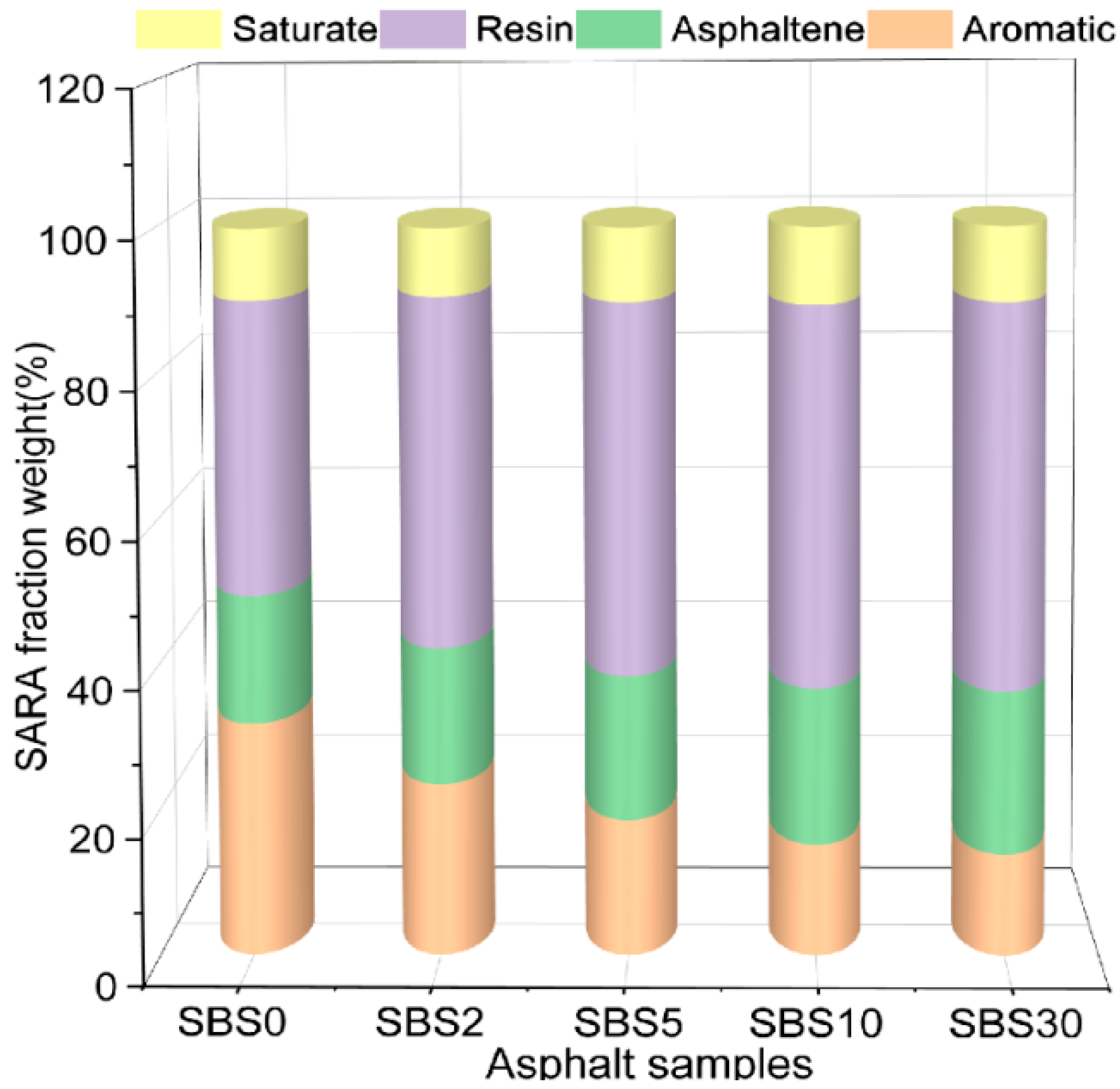
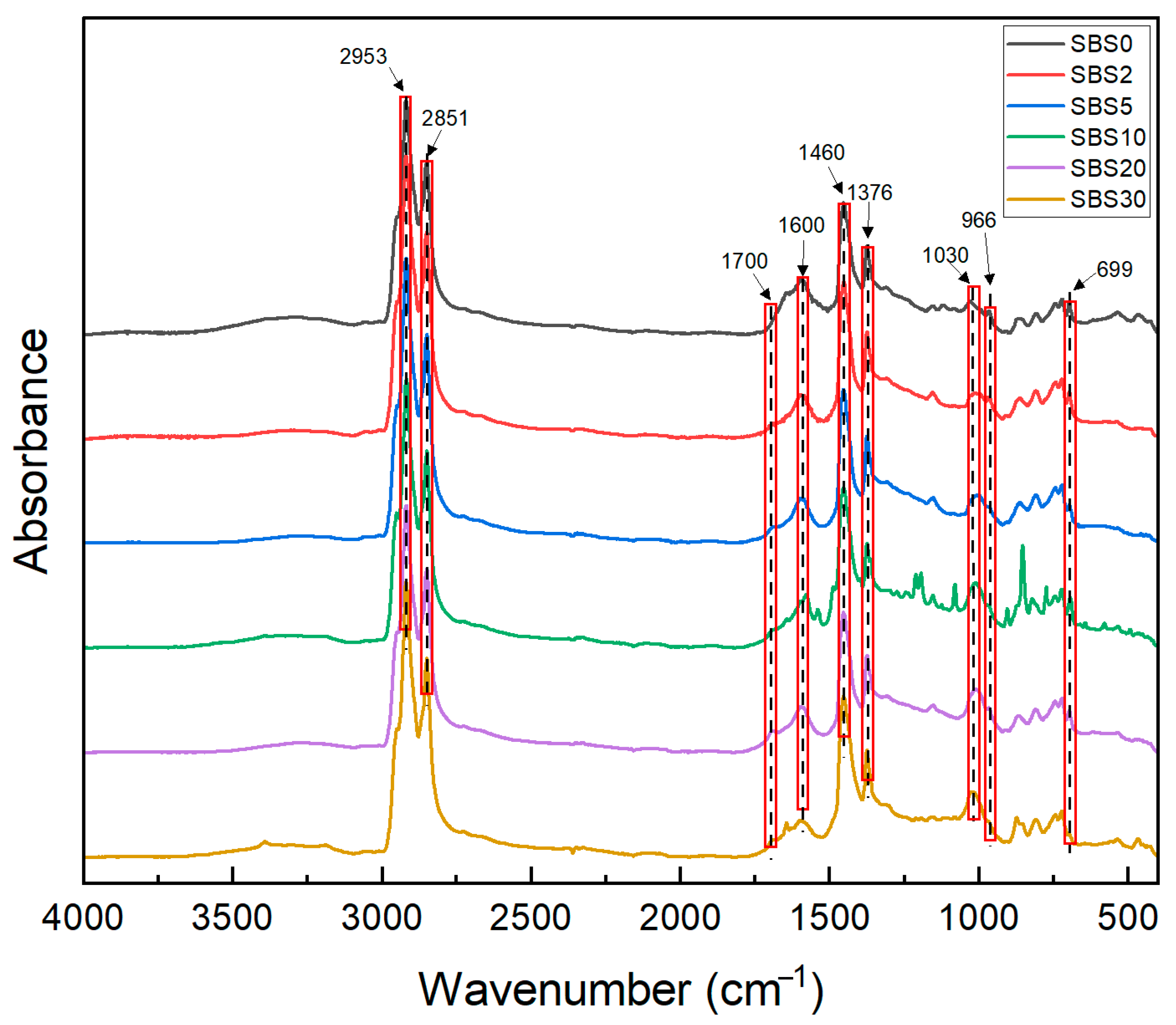
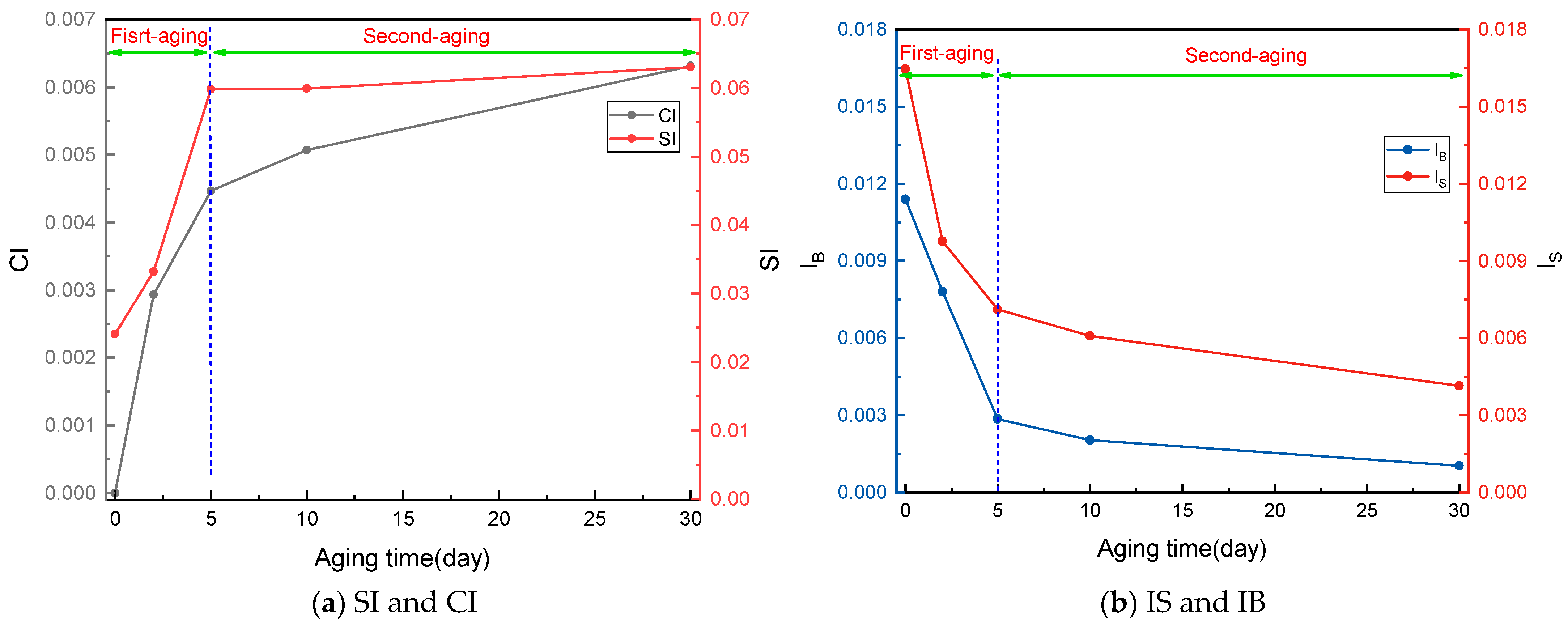
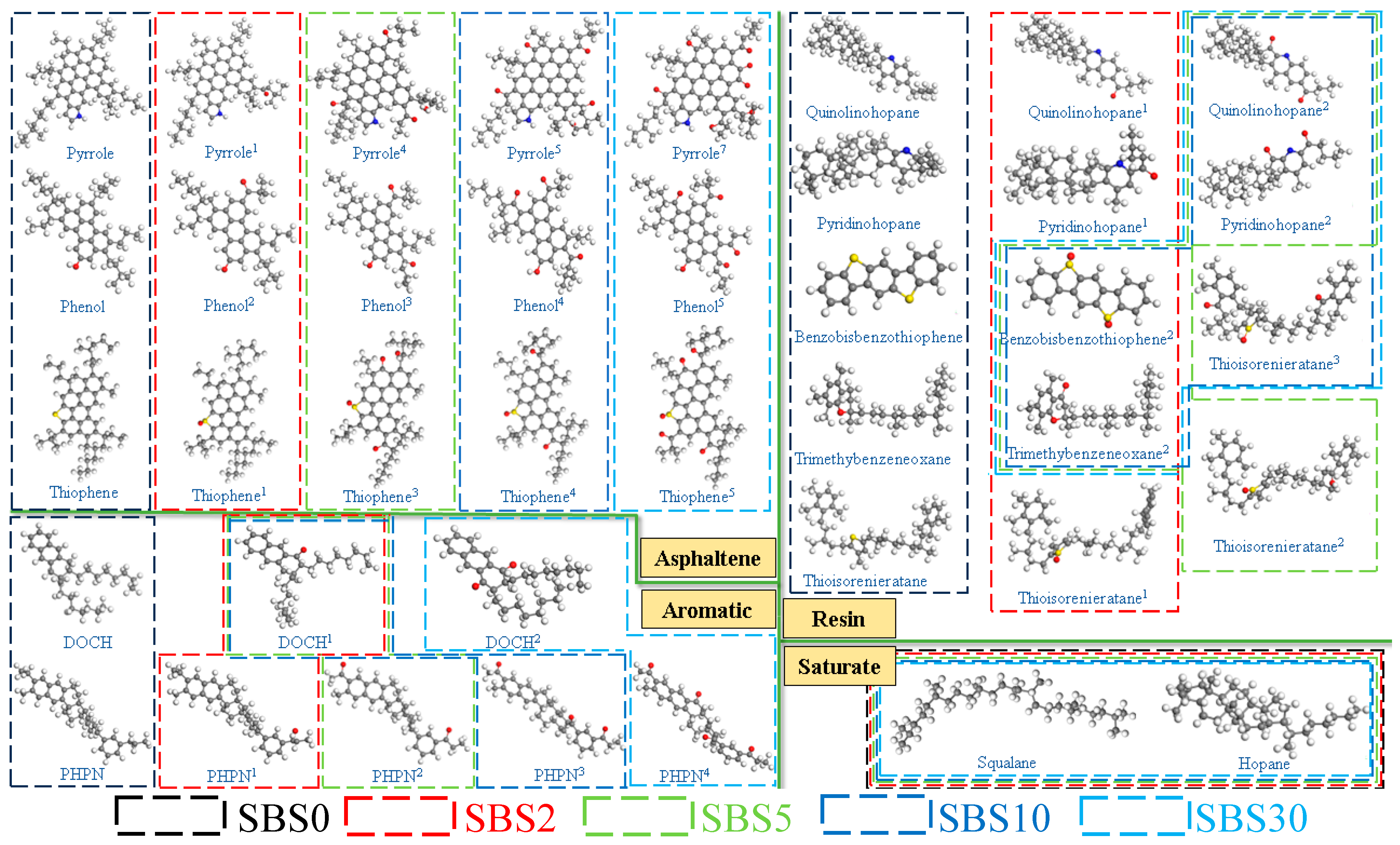

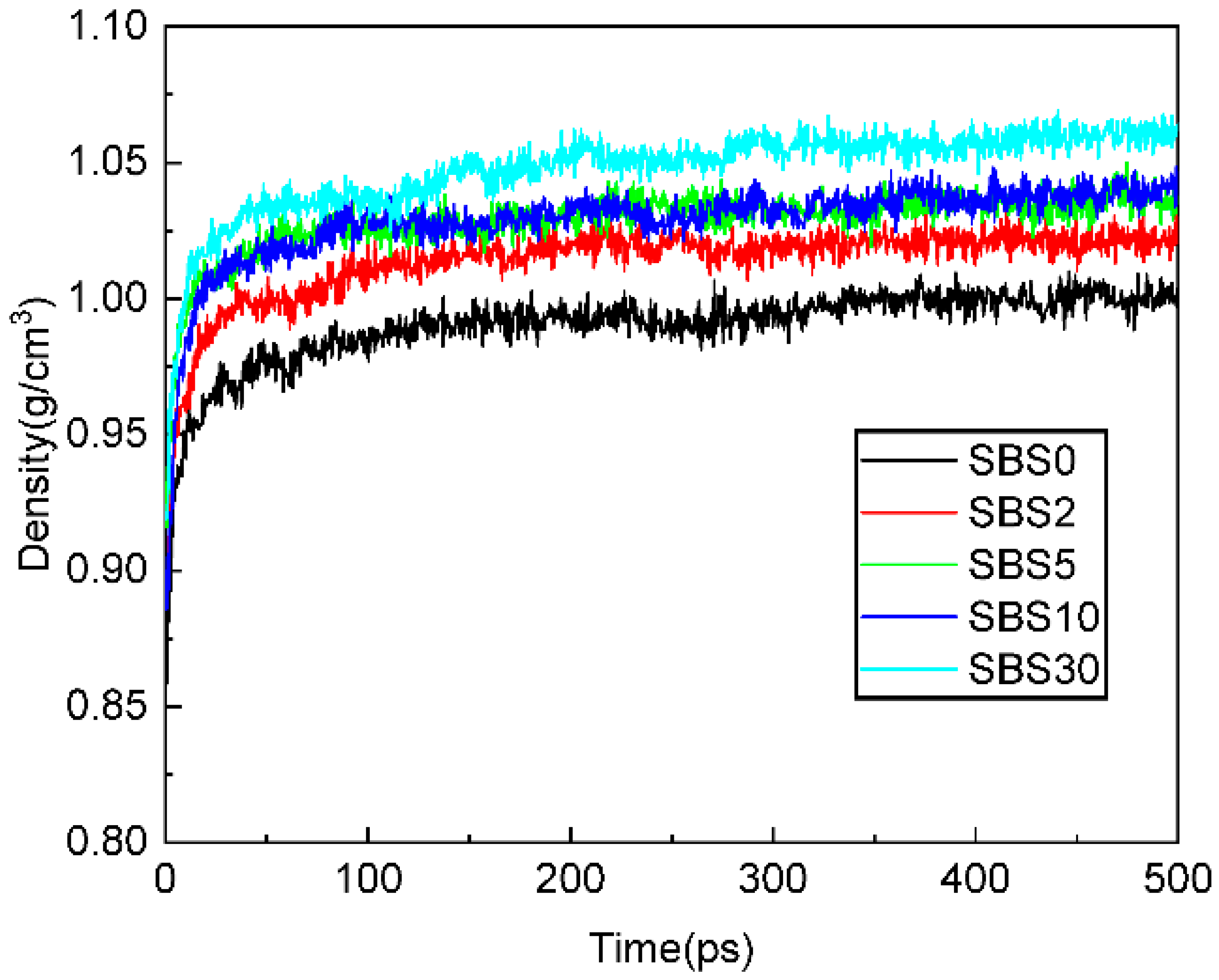
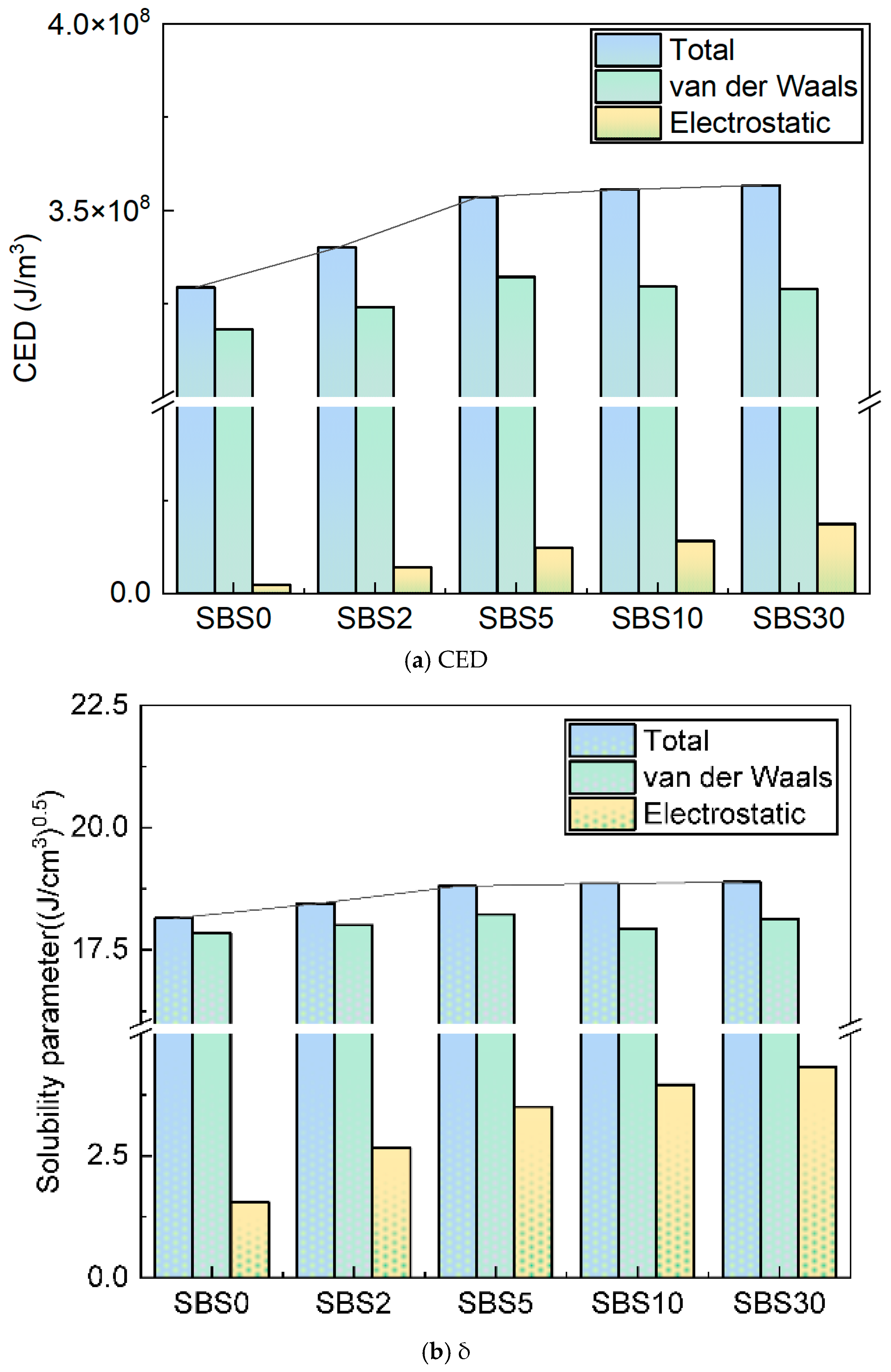
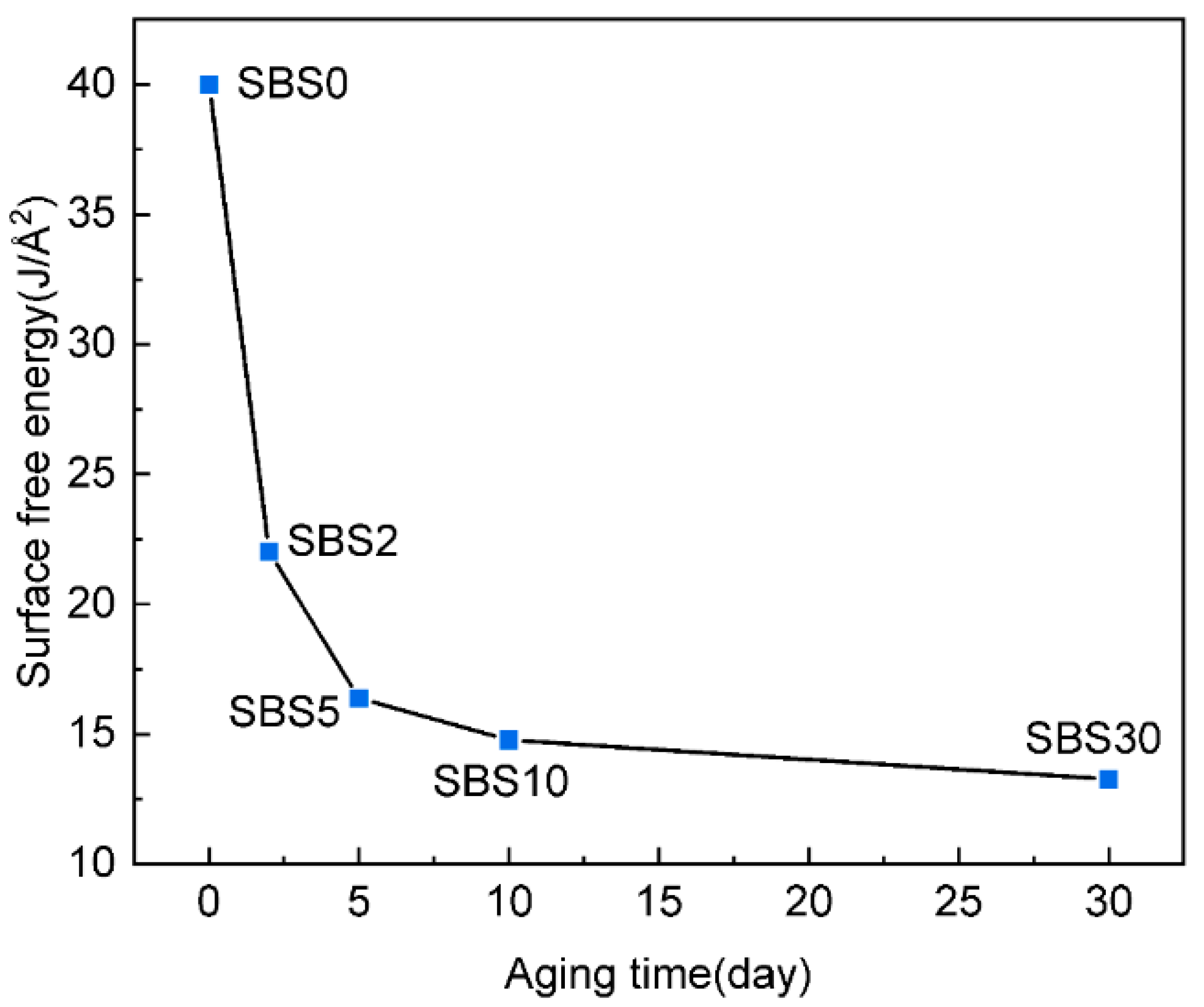
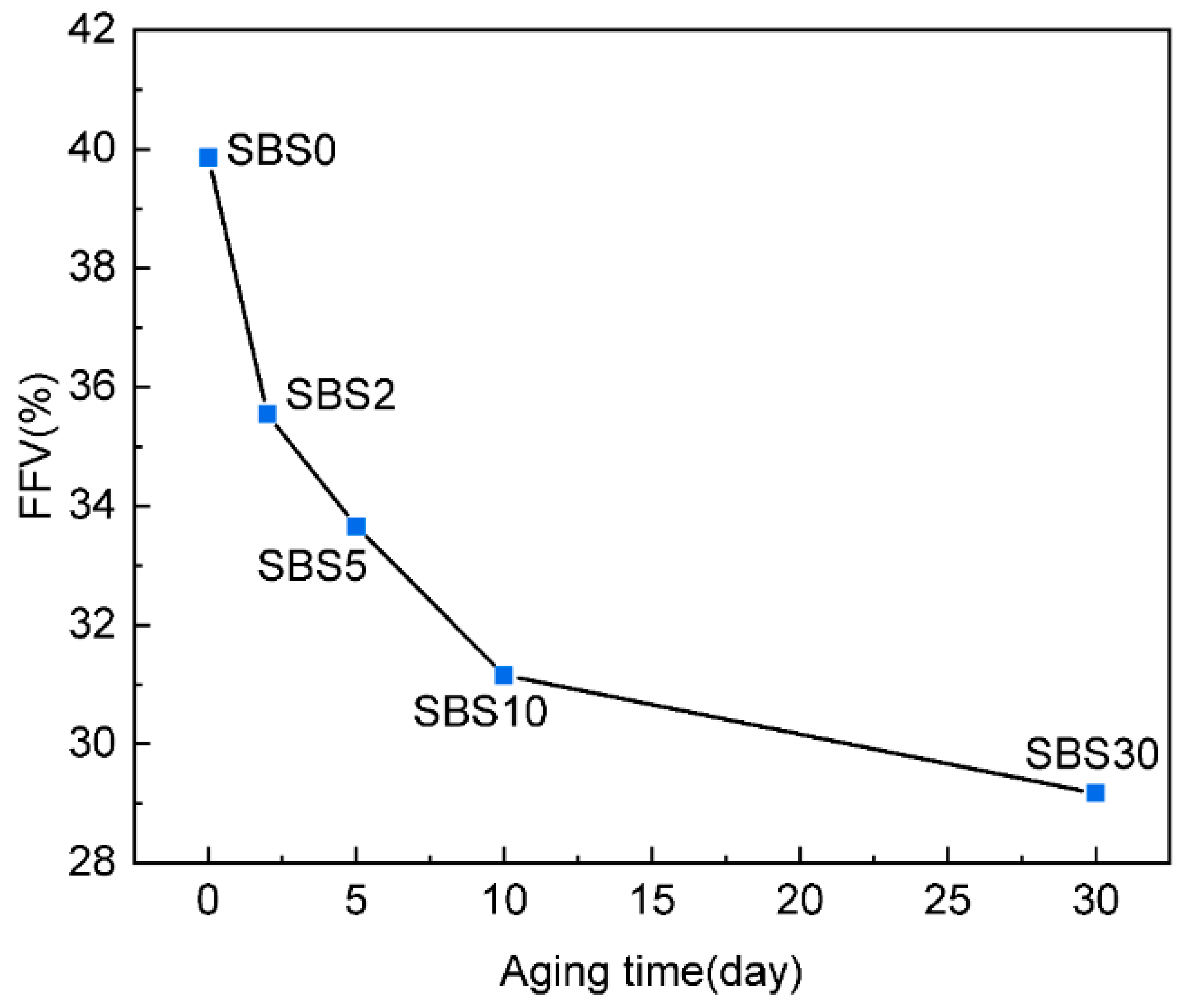
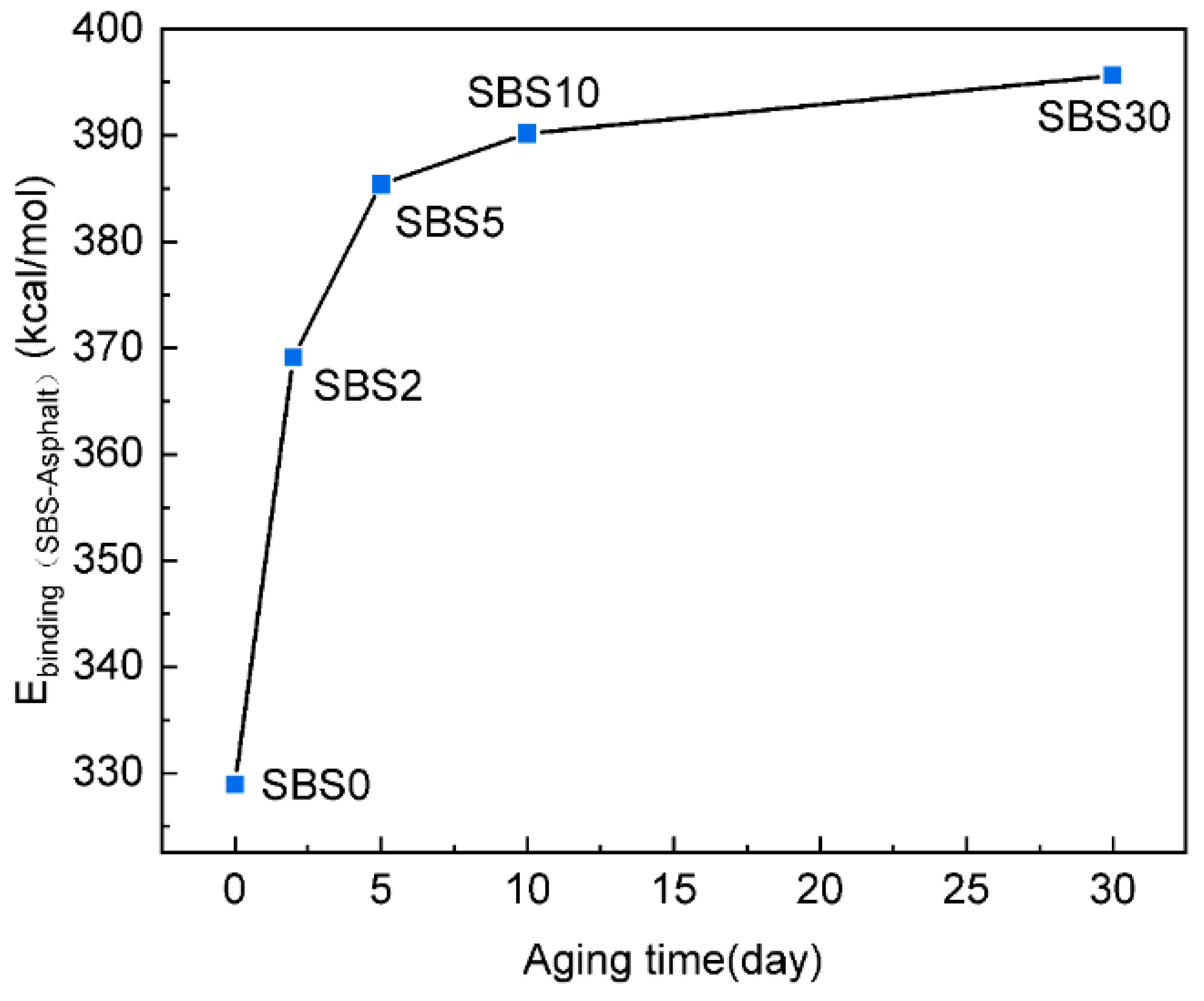
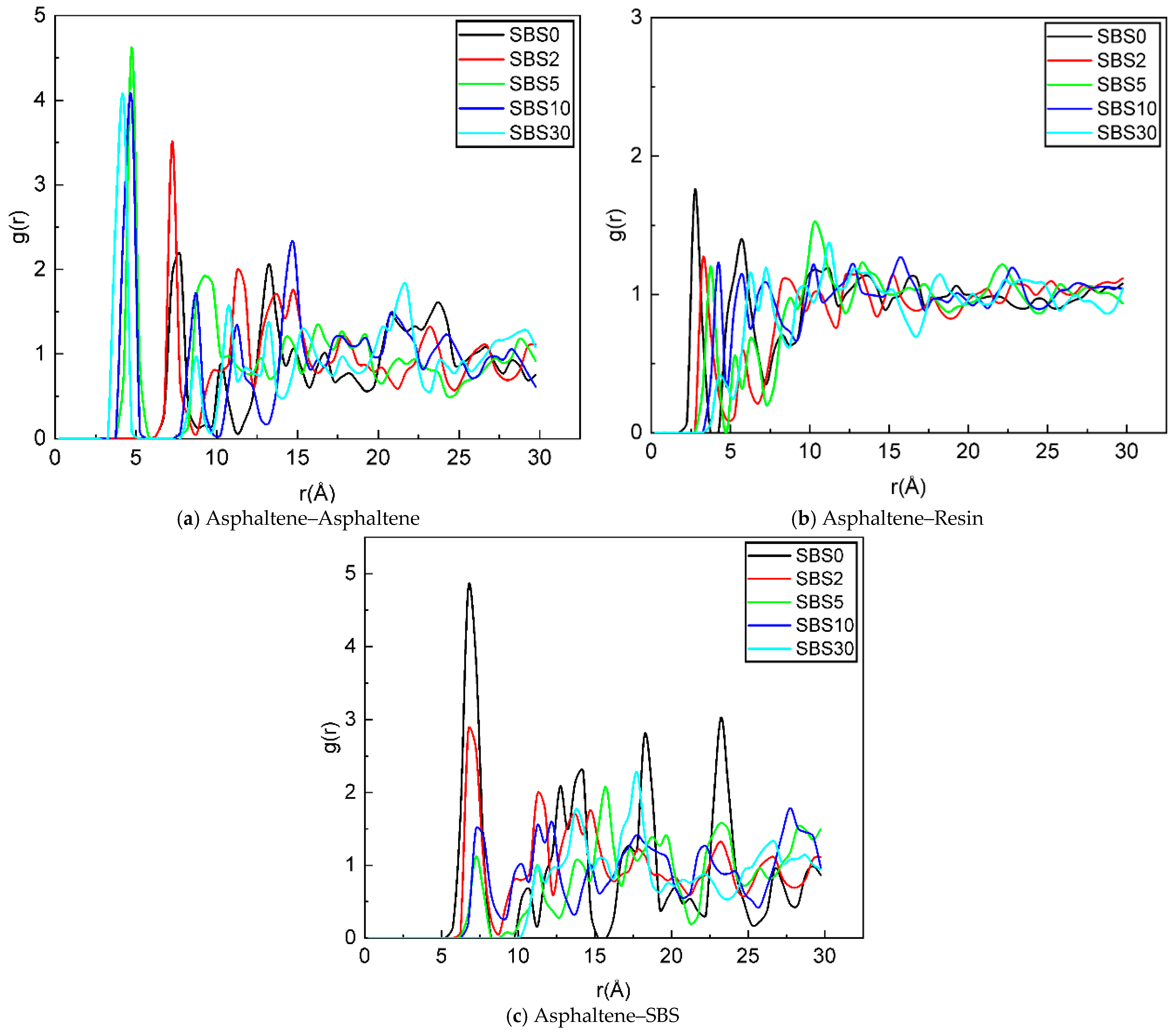
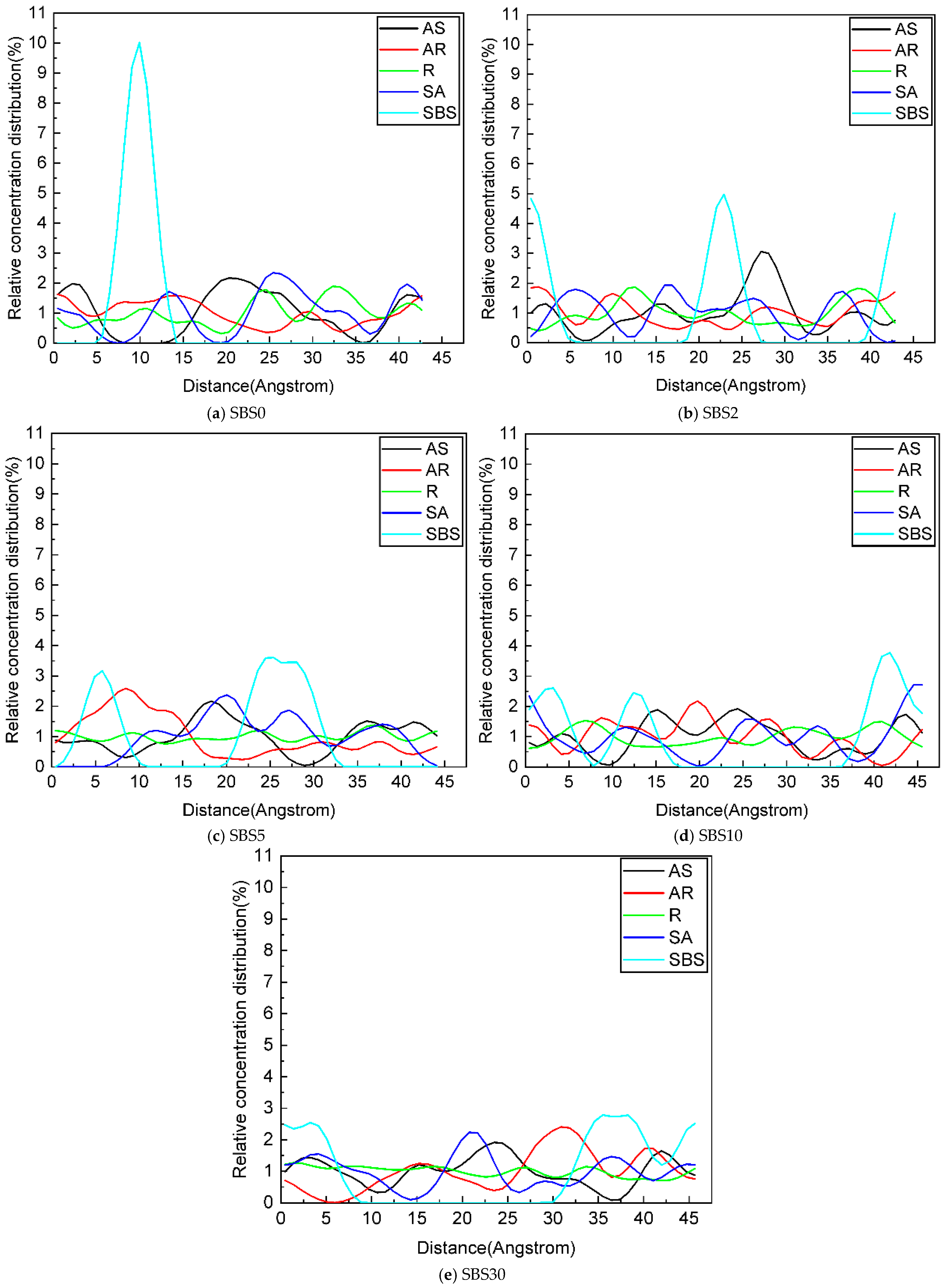
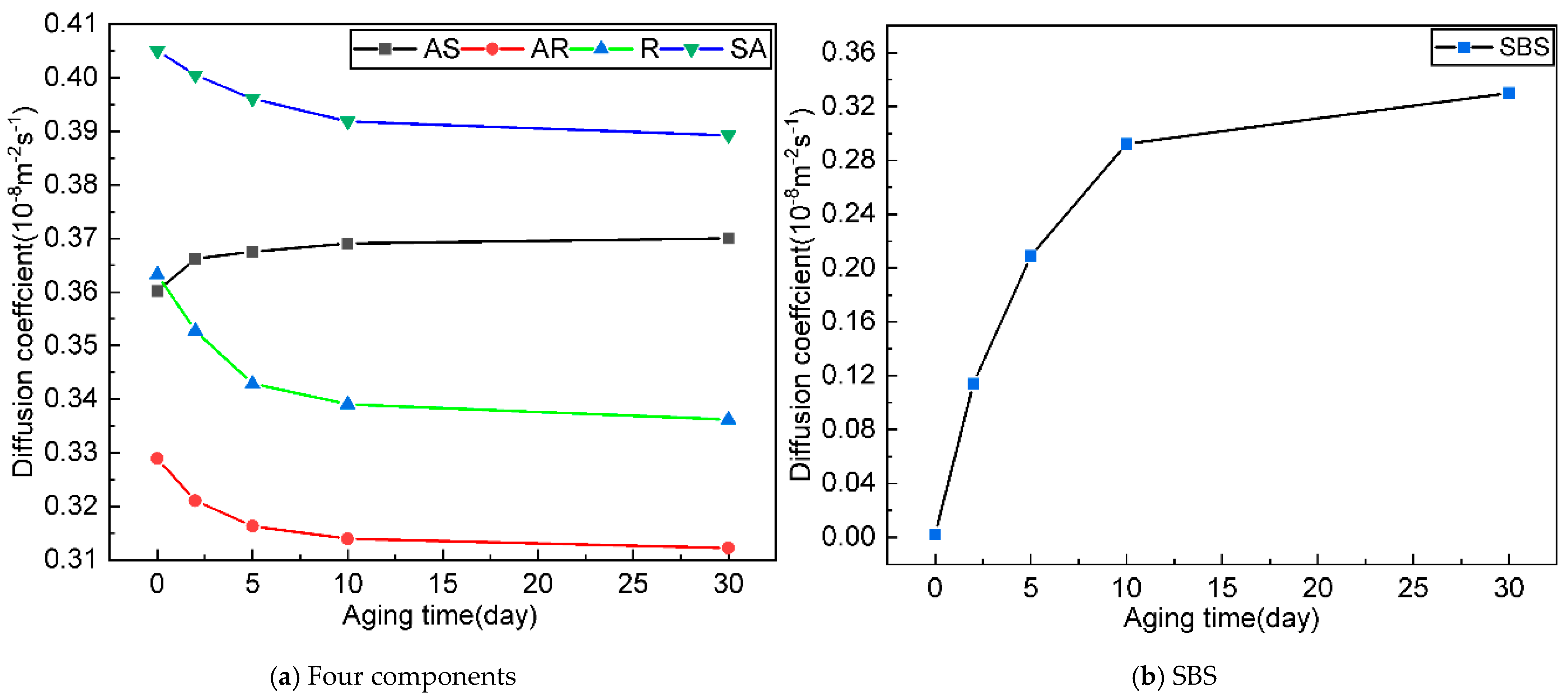
| Properties | Test Results of Base Asphalt | Technical Standards | Test Results of SBSMA | Technical Standards | Test Method |
|---|---|---|---|---|---|
| Penetration (25 °C, 0.1 mm) | 69.7 | 60–80 | 58.9 | 30–60 | T0604-2011 |
| Ductility (15 °C, cm) | >10 | ≥10 | 22.1 | ≥20 | T0605-2011 |
| Softening Point (°C) | >43 | ≥43 | 76.3 | ≥60 | T0606-2011 |
| Wavenumber (cm−1) | Vibration Mode | Assignment |
|---|---|---|
| ~2953 | C-H asymmetric stretch | Aliphatic CH2 in asphalt and SBS |
| ~2851 | C-H symmetric stretch | Aliphatic CH2 in asphalt and SBS |
| ~1700 | C=O stretch | Carbonyl groups (products of oxidation) |
| ~1600 | C=C stretch | Aromatic rings in asphalt and polystyrene |
| ~1542 | N-O stretch/C=C stretch | Nitro compounds/Conjugated systems |
| ~1460 | C-H bending | Aliphatic CH2/CH3 in asphalt and SBS |
| ~1376 | C-H bending | Aliphatic CH3 in asphalt |
| ~1199 | C-O/S-O stretch | Esters, Sulfonic acids |
| ~1086 | S=O stretch | Sulfones |
| ~1030 | S=O stretch | Sulfoxide groups (products of oxidation) |
| ~966 | C=C-H bend | Trans-polybutadiene segment in SBS |
| ~699 | C-H bend | Monosubstituted benzene ring (polystyrene) |
| Model Classification | Molecular Name | Molecular Formula | Number of Molecules of SBS0 | Number of Molecules of SBS2 | Number of Molecules of SBS5 | Number of Molecules of SBS10 | Number of Molecules of SBS30 |
|---|---|---|---|---|---|---|---|
| Aromatic | Dioctyl-cyclohexane-Naphthalene (DOCHN) | C30H46 | 16 | 12 | 10 | 8 | 8 |
| Aromatic | Perhydrophenanthrene-naphthalene (PHPN) | C35H44 | 18 | 14 | 12 | 12 | 10 |
| Asphaltene | Phenol | C42H54O | 5 | 5 | 5 | 6 | 6 |
| Asphaltene | Pyrrole | C66H81N | 3 | 3 | 3 | 4 | 4 |
| Asphaltene | Thiophene | C51H62S | 5 | 6 | 6 | 6 | 6 |
| Resin | Benzobisbenzothiophene | C18H10S2 | 5 | 6 | 8 | 10 | 10 |
| Resin | Pyridinohopane | C36H57N | 5 | 6 | 8 | 10 | 10 |
| Resin | Quinolinohopane | C40H59N | 20 | 21 | 22 | 23 | 24 |
| Resin | Thio-isorenieratane | C40H60S | 6 | 8 | 10 | 11 | 12 |
| Resin | Trimethybenzeneoxane | C29H50O | 7 | 9 | 12 | 13 | 14 |
| Saturate | Hopane | C35H62 | 5 | 5 | 6 | 7 | 7 |
| Saturate | Squalane | C30H62 | 5 | 5 | 6 | 7 | 7 |
| SBS | C158H163 | 1 | - | - | - | - | |
| Broken SBS I | C22H24O | 1 | 1 | 1 | 1 | 1 | |
| Residual SBS I | C136H141O | 1 | 1 | - | - | - | |
| Broken SBS II | C29H32O | 1 | - | 1 | 1 | 1 | |
| Residual SBS II | C107H112O2 | 1 | - | 1 | - | - | |
| Broken SBS III | C53H58O3 | 1 | - | - | 1 | 1 | |
| Broken SBS IV | C54H57O | 1 | - | - | 1 | 1 |
Disclaimer/Publisher’s Note: The statements, opinions and data contained in all publications are solely those of the individual author(s) and contributor(s) and not of MDPI and/or the editor(s). MDPI and/or the editor(s) disclaim responsibility for any injury to people or property resulting from any ideas, methods, instructions or products referred to in the content. |
© 2025 by the authors. Licensee MDPI, Basel, Switzerland. This article is an open access article distributed under the terms and conditions of the Creative Commons Attribution (CC BY) license (https://creativecommons.org/licenses/by/4.0/).
Share and Cite
Nie, Y.; Bai, Y.; Liu, F.; Li, P.; Zhou, Z. Molecular Insights into the Kinetic Aging Mechanisms of SBS-Modified Asphalt. Materials 2025, 18, 4821. https://doi.org/10.3390/ma18214821
Nie Y, Bai Y, Liu F, Li P, Zhou Z. Molecular Insights into the Kinetic Aging Mechanisms of SBS-Modified Asphalt. Materials. 2025; 18(21):4821. https://doi.org/10.3390/ma18214821
Chicago/Turabian StyleNie, Yunjing, Ye Bai, Fang Liu, Pengfei Li, and Zhidong Zhou. 2025. "Molecular Insights into the Kinetic Aging Mechanisms of SBS-Modified Asphalt" Materials 18, no. 21: 4821. https://doi.org/10.3390/ma18214821
APA StyleNie, Y., Bai, Y., Liu, F., Li, P., & Zhou, Z. (2025). Molecular Insights into the Kinetic Aging Mechanisms of SBS-Modified Asphalt. Materials, 18(21), 4821. https://doi.org/10.3390/ma18214821






